Rob Hoffman, R.I.P.
Rob Hoffman, who with Henry Beard and Doug Kenney founded National Lampoon in 1970, died on August 19 of lukemia at the age of 59. I will post links to obits when I am able to find them. If you know of any, let me know.
Update: “Hoffman shaped Dallas’ future with vision, wit, intellect” from DallasNews.com. (Thanks, Michael.)
Interview: Josh Karp, Author of New Doug Kenney Book
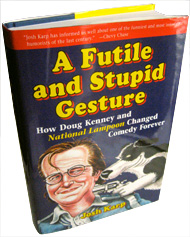
 Josh Karp, author of “A Futile and Stupid Gesture: How Doug Kenney and National Lampoon Changed Comedy Forever,”
Josh Karp, author of “A Futile and Stupid Gesture: How Doug Kenney and National Lampoon Changed Comedy Forever,” graciously agreed to an interview. This is somewhat of a departure from my usual news items, which lately have been short and infrequent. So this is a pretty big deal. But then, I think this book is a pretty big deal. If you have any interest in Doug Kenney or National Lampoon, you will love this book. In my opinion, this is one of the best, if not the best, books on National Lampoon written yet. As promised, here is the interview.
graciously agreed to an interview. This is somewhat of a departure from my usual news items, which lately have been short and infrequent. So this is a pretty big deal. But then, I think this book is a pretty big deal. If you have any interest in Doug Kenney or National Lampoon, you will love this book. In my opinion, this is one of the best, if not the best, books on National Lampoon written yet. As promised, here is the interview.
Mark: Where did you get the idea to do this book? Why did you want to do it?
Josh: When I was 14, my dad got me a job in the mailroom of the law firm that represented his company. The guy who ran the mailroom had every Lampoon ever published and brought them to work. This was 1980, right around the time Doug died and somehow I read the Esquire article about him dying [Death of a Comic Genius, by Robert Sam Anson, August 1981], and it always stuck with me. So, 23 years later, when I was looking for my first book project, I thought, I can’t believe nobody did a book about this guy, or really about Lampoon, which was really the cornerstone of much of my worldview in many ways. Or at least my sense of humor.
M: So, you weren’t reading National Lampoon back when Kenney was at the magazine?
J: Some of my friend’s older brothers read it, so I’d seen it. But when I was 12, I saw Animal House, and then when I was 14, I spent the summer in the law firm mailroom, reading every single issue of the magazine. So, no, I wasn’t a regular reader during the 1970s. In fact, my single favorite Lampoon piece at that time (other than the High School Yearbook Parody) Was Ted Mann and Tod Carroll’s “O.C. and Stiggs.” which I thought was the funniest thing in the world when I was 20.
M: I was amazed at the shear number of people you interviewed for the book. Were people reluctant or eager to talk to you?
J: Both. Lots of the people who were being interviewed only about Doug were reluctant. Many of them felt really burned by the Esquire piece and it’s depiction of Doug, so that was hard to crack. And others, for varying reasons, were not interested in talking. But many, many were really excited to talk and helped me crack some of those who didn’t want to talk. Some who initially didn’t want to talk—like Brian McConnachie—wound up being some of my favorite people and interviews.
M: I bet he was pretty interesting.
J: Brian is one of my favorite people I met from working on the book and re-reading his work in National Lampoon is so much fun. He is so brilliantly original. Nobody else thinks like him. We sat on his porch one summer day and he told me about things he’d worked on that were so insanely funny that I was exhausted when I got back in my car to leave.
M: One of my favorites of his is “Pamplemouse.”
J: I think that was his first. My favorite has to be Guns and Sandwiches, his parody magazine which is a merger between two failing magazines—one focused on the gun industry and the other about sandwiches. His concept was that they were both very bad magazines and they merged out of necessity. To reflect how poorly run they are, he has a letter to the editor that reads something like: “In your article about the sandwiches Charles Whitman brought with him to the tower in Texas [for his shooting spree] you show a picture of the actor James Whitmore. What does he have to do with this?” That, to me, is one of the funniest things ever in the magazine. Though I’m sure my retelling doesn’t do it justice.
M: I’ll have to re-read that one. That was from a time when I wasn’t reading the magazine as thoroughly.
J: Brian is just completely original. Nobody else sees the world or humor the way he does. He’s also, I believe, the only person to ever write for the Lampoon, Saturday Night Live and SCTV.
M: What was your favorite part of writing the book? Least favorite?
J: My absolute favorite thing was meeting and talking to people who’d worked at Lampoon. They were all just so smart and funny. Sean Kelly and Brian stand out, but there are others. Chris Miller, he was the first person that I’d met who worked there. And I thought “Jesus, the guy who wrote Night of the Seven Fires” and was one third of the Animal House writing team.
I also just loved learning about the inner workings of the magazine and about Doug’s life. Which also was the hard part. I truly liked everyone I spoke with and then had to write about them with complete honesty—which as time wore on became a big deal and very hard, because they weren’t all saints. Though, I’m not sure any of them view themselves as such.
So, it was tough to have to be the biographer and journalist after developing relationships with the people I was writing about. but, I think the book is a really honest reflection of who they were and what it was like to be at National Lampoon in the 1970s.
M: Yeah, I get a very vivid sense of what it was like to be there—more so than other books that have been written about people at the
magazine.
J: Thanks. I think that’s because I didn’t actually work there, so I had to do the research and create a mental image for myself, which somebody who was there doesn’t have to do. Strangely, I think it’s easier to paint the picture if you haven’t actually physically seen the image of something.
A good example of that is with Doug. Other than a few bits on the radio hour and his work as stork and a tiny, tiny scene in Caddyshack, there is
absolutely no video or audio of him. I really didn’t even know what his voice sounded like. I had to get it all from other people and put it together myself. That was a big challenge.
M: One of the things that’s unusual in the way you paint a picture of life at the Lampoon is that you talked to people who are not so well known—the “little” people, like copy editors and
assistants, etc.
J: Yeah, that was both by design and at points out of desperation and fear. I wanted to make sure I got it as completely and correctly as possible (the fear angle). At first I was worried about who would and wouldn’t speak to me so I tried to find everyone listed in the Tenth Anniversary Anthology (on the masthead) and finally, I’ve worked a lot of places and knew that the people behind the scenes are the ones who really know what’s happening.
M: Right.
J: They’re the people who get the front row seat to what people are like. It’s like interviewing the bat boys and locker room attendants for the Yankees of the late 1970s. They could tell you all about what Reggie Jackson or Billy Martin was really like. That was a huge help in fleshing out a lot of people like P.J. and Doug.
M: What surprised you most to learn about Doug Kenney?
J: This may sound boring, but the depth of his work and his talent is what really surprised me. As a person, I learned so much about him—some of it surprising. But what amazed me was his work. Of all the people there, he was the greatest talent and had the most uncanny ability to write really funny things that had a strong viewpoint, but carried so many elements, hidden jokes and depth, that I was just blown away.
M: Here’s a question that one of my readers wanted me to ask (he has read an advanced copy of the book already): Did you hear of any ideas that Doug Kenney had for issues, articles, movies or whatever that you think might have changed the course of National Lampoon?
J: Not that I can recall at the moment. I think that by the time Animal House was in the theaters, he was pretty much done with National Lampoon, at least as far as being an employee. So, at that point, for whatever reason, he was not still doing stuff there. But, I can think about it and see if I can recall anything else.
M: What do you think Kenney would be doing now if he were still alive?
J: A lot of people like to say stuff like, “he’d own Hollywood” and would be some huge producer or screenwriter. That might be the truth, but I suspect that somehow, he’d have gotten out of there. I’m not sure what he’d have done, but I think he really needed to find himself. I don’t think he’d have become the next Woody Allen or something like that. I think he’d have soured on the business and figured out something else to do with his talents. What, I’m not sure.
M: What has been the reaction to the book from people who knew and worked with him, some of whom no doubt have seen the book by now?
J: Michael Simmons is the only person who worked there or was around whose read it so far. Everyone else is getting their copies in late August when I get them from my publisher. And Michael loved it. He’s been very kind. He said that some parts made him cry and that I’d captured doug and the entire scene just as he remembered it, which was very nice of him. I hope others feel that way as well.
M: Do you think we will ever know what really happened on
that cliff in Hawaii?
J: I’m not sure what else there would be to find out. The police concluded it was an accident. And there are people with such varying views of what might have happened. But, in the end, the only person who knows is Doug. Though, I think the fact that there is so much question as to the nature of his death is very in keeping with his personality—kind of leaving so many possibilities open.
M: Well, that’s about all I have. One more thing: How did you get Rick Meyerwitz to do the cover?
J: Rick is a great, great guy and we became friendly during my work on the book. When it came time to find a cover artist, I thought he or Bruce McCall would be perfect. But, rick was really the person whose work was more identifiably Lampoon-ish and he very graciously agreed to do it.
M: All right. Thanks, Josh, and good luck with the book.
J: Thanks, Mark.
Doug Kenney Book Will be Out in September
“A Futile and Stupid Gesture: How Doug Kenney and National Lampoon Changed Comedy Forever,” by Josh Karp, will be out in September. The book has been in the works for over three years. I am planning to do an interview with Josh about the book in the near future and will post it here. P.S.: You can pre-order the book from Amazon.com .
.
’Poon Parody from Down Under
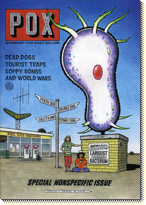 Two gals from down under have managed to pull off an amazing feat: A pitch-perfect parody of vintage 1970s-era National Lampoon. POX is a comic book published “intermittently” by Susan Butcher and Carol Wood out of somewhere in the middle of Australia. It’s funny, clever, and quirky (and drawn by hand). Carol says she discovered the ‘Poon in the mid-1970s as a 16-year-old living in Perth, Western Australia. It was a mind-blowing experience and Lampoon magazine and books became her only contact with the outside world.
Two gals from down under have managed to pull off an amazing feat: A pitch-perfect parody of vintage 1970s-era National Lampoon. POX is a comic book published “intermittently” by Susan Butcher and Carol Wood out of somewhere in the middle of Australia. It’s funny, clever, and quirky (and drawn by hand). Carol says she discovered the ‘Poon in the mid-1970s as a 16-year-old living in Perth, Western Australia. It was a mind-blowing experience and Lampoon magazine and books became her only contact with the outside world.
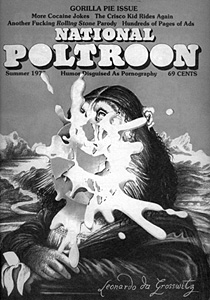 Which explains the fabulous job she and Susan did on “National Poltroon,” a 16-page parody of National Lampoon featured in POX Number Six. Given their limited resources, it’s not as lavishly produced as the original (black and white on newsprint), but it perfectly captures the tone and style of the magazine at its peak. In a jam-packed 16 pages they manage to have a little fun with practically every artist and writer of the era–P.J. O’Rourke, Chris Miller, Henry Beard, Vaughn Bodé, Michael Gross, Rick Meyerowitz, Bruce McCall(!), and more.
Which explains the fabulous job she and Susan did on “National Poltroon,” a 16-page parody of National Lampoon featured in POX Number Six. Given their limited resources, it’s not as lavishly produced as the original (black and white on newsprint), but it perfectly captures the tone and style of the magazine at its peak. In a jam-packed 16 pages they manage to have a little fun with practically every artist and writer of the era–P.J. O’Rourke, Chris Miller, Henry Beard, Vaughn Bodé, Michael Gross, Rick Meyerowitz, Bruce McCall(!), and more. 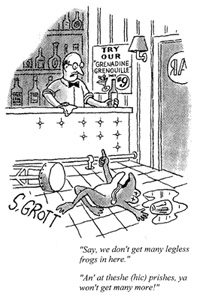 There are spoofs of cartoons—Cheech Wizard, Politenessman, Verman, B. Kliban, Edward Gorey, Gahan Wilson, Charles Rodriguez, Roz Chast, Bob Mankoff, Sam Gross, Shary Flenniken, Ed Subitzky, M.K. Brown, Randy Enos, Jeff Jones, Bruce Cochrane, Foto Funnies, etc., etc. Some of these are very brief, but all of them lovingly mimick each cartoonist’s style to a T. Did I mention the subscription cards? The Surprise Poster? The Son ‘o God comics parody? The contents page? The Off-Broadway show? The obligatory “hip” liquor/tobacco/hi-fi ad? It’s hard to believe how much they managed to squeeze into this little parody. It’s clearly a labor of love—as much a tribute as a spoof.
There are spoofs of cartoons—Cheech Wizard, Politenessman, Verman, B. Kliban, Edward Gorey, Gahan Wilson, Charles Rodriguez, Roz Chast, Bob Mankoff, Sam Gross, Shary Flenniken, Ed Subitzky, M.K. Brown, Randy Enos, Jeff Jones, Bruce Cochrane, Foto Funnies, etc., etc. Some of these are very brief, but all of them lovingly mimick each cartoonist’s style to a T. Did I mention the subscription cards? The Surprise Poster? The Son ‘o God comics parody? The contents page? The Off-Broadway show? The obligatory “hip” liquor/tobacco/hi-fi ad? It’s hard to believe how much they managed to squeeze into this little parody. It’s clearly a labor of love—as much a tribute as a spoof.
Unfortunately, POX is not distributed outside of Australia (yet). However, Susan and Carol are willing to send copies to readers in America for five US dollars each. Send well-concealed cash to: Butcher and Wood, 17 King St, Daylesford VIC 3460, Australia.
Lampoon Discussed at Comics Journal
Interesting discussion about National Lampoon over at The Comics Journal discussion board last month, spurred by a job posting by National Lampoon Press. Update: Unfortunately, that link has gone dead.
Belushi Podcast
Jesse Thorn, host and producer of The Sound of Young America radio show, dropped me a line to say that his recent interview with Judith Belushi Pisano and Tanner Colby, authors of the recently released biography of John Belushi (see the previous item below), can be heard over the internet (link). It’s nearly an hour long and features John Belushi performances from National Lampoon Radio Hour and Saturday Night Live. (Note: You don’t need an iPod to listen to a podcast. It should play right from your web browser when you click on the link.) Update: The linked material has vanished from the ether.
Holy Moses!
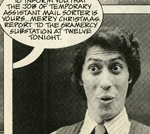 Every so often I hear from someone who was affiliated with National Lampoon in one way or another. The most recent is Andy Moses, an erstwhile comic actor who appeared in the stage production of That’s Not Funny, That’s Sick! Andy is alive and well and living in New York City with his wife and cats. After getting out of the acting business, he became a bartender, a diamond salesman, a chef, and a partner in a comic book store. He still hangs out with some of the old NatLamp players, including the talented Paul Jacobs.
Every so often I hear from someone who was affiliated with National Lampoon in one way or another. The most recent is Andy Moses, an erstwhile comic actor who appeared in the stage production of That’s Not Funny, That’s Sick! Andy is alive and well and living in New York City with his wife and cats. After getting out of the acting business, he became a bartender, a diamond salesman, a chef, and a partner in a comic book store. He still hangs out with some of the old NatLamp players, including the talented Paul Jacobs.
Andy notes that he and Sarah Durkee (another light of the NatLamp stage) wrote and performed CBS Radio’s Almost Comedy Hour. It aired in June of 1983 and also featured Louise Gikow as a writer (who also played organ as part of a kiddie show parody). Guest host was Don Novello (a.k.a., Father Guido Sarducci) with guests Franken and Davis, Firesign Theatre, and (surprisingly) Milton Berle, who appeared in a Nick Danger sketch with Firesign Theatre.
Andy also appeared in the magazine several times. In the March 1978 (Crime and Punishment) issue, he appeared in a mug shot in the John Hughes piece “Random, Pointless, Senseless Crimes” as Cousins Molockney, wanted for mailing dog feces. In the December 1978 (Food & Festivity) issue, he is featured in a Foto Funny about a guy who gives a quarter to a bum who turns out to be the Postal Fairy, and gives him a job at the post office for Christmas. He appeared in the February 1979 (Heterosexuality) issue cavorting with other nude people (including Rodger Bumpass and Oui model Margie Beck) in “A Visit to Nero’s Pleasure Palace.” (He made a few more appearances in the magazine, but I haven’t tracked them all down.)
Thanks for the update, Andy!
Big Blue Belushi Book
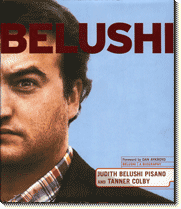 Rugged Land has just published Belushi: A Biography by Judith Belushi Pisano and Tanner Colby. This is a very big book filled with photos, many never published before, and page after page of reminiscences and anecdotes by the people who knew and worked with John Belushi during his brief but brilliant career. His excesses are not left out, but this book is a tribute, not an exposé. The book is organized chronologically, starting with his childhood in Chicago, through college, Second City, National Lampoon’s Lemmings, the Radio Hour, Saturday Night Live, Animal House, the Blues Brothers, and other movies, up to his death in 1982. Most people know him for Saturday Night Live, but he was a central figure in most of National Lampoon’s non-magazine ventures, and not only as a performer.
Rugged Land has just published Belushi: A Biography by Judith Belushi Pisano and Tanner Colby. This is a very big book filled with photos, many never published before, and page after page of reminiscences and anecdotes by the people who knew and worked with John Belushi during his brief but brilliant career. His excesses are not left out, but this book is a tribute, not an exposé. The book is organized chronologically, starting with his childhood in Chicago, through college, Second City, National Lampoon’s Lemmings, the Radio Hour, Saturday Night Live, Animal House, the Blues Brothers, and other movies, up to his death in 1982. Most people know him for Saturday Night Live, but he was a central figure in most of National Lampoon’s non-magazine ventures, and not only as a performer.
It’s rather surprising that it’s taken so long for a book like this to be published. Other books have been written about Belushi, but they tend to focus on what went wrong. This one is about what went right and what made him such a unique talent. If you’re a fan, there’s no question: Ya gotta get it.
If You Don’t Read This Item, I’ll Kill This Blog
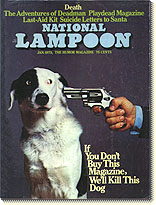 The Society of Magazine Editors has selected the top magazine covers of the last 40 years and the cover of the January 1973 (Death) issue (“If You Don’t Buy This Magazine, We’ll Kill This Dog”) made the top ten. For such a memorable and oft parodied cover, this does not surprise me. Michael C. Gross, who art directed the cover, commented, “No shit!…wow.” Congrats to Mike, Ed Bluestone (whose idea it was), and photographer Ronald G. Harris. To those who did not buy the issue, how can you sleep knowing that an innocent dog’s life could have been saved but for your selfish indifference?
The Society of Magazine Editors has selected the top magazine covers of the last 40 years and the cover of the January 1973 (Death) issue (“If You Don’t Buy This Magazine, We’ll Kill This Dog”) made the top ten. For such a memorable and oft parodied cover, this does not surprise me. Michael C. Gross, who art directed the cover, commented, “No shit!…wow.” Congrats to Mike, Ed Bluestone (whose idea it was), and photographer Ronald G. Harris. To those who did not buy the issue, how can you sleep knowing that an innocent dog’s life could have been saved but for your selfish indifference?
Kids Say the Darndest Things
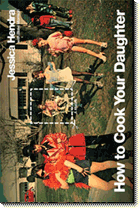 When I heard the title of Jessica Hendra’s book, “How to Cook Your Daughter,”
When I heard the title of Jessica Hendra’s book, “How to Cook Your Daughter,” I wasn’t sure if I wanted to read it. The title is taken from the title of a story by her father, Tony Hendra, that appeared in the July 1971 (Kids) issue. I had heard about, but not followed, the story that broke this last summer in The New York Times in which she revealed that her father’s bestselling and critically praised book, “Father Joe,” which purports to be a confessional of a lifetime of sins, neglected to include his sexual abuse of her as a child.
I wasn’t sure if I wanted to read it. The title is taken from the title of a story by her father, Tony Hendra, that appeared in the July 1971 (Kids) issue. I had heard about, but not followed, the story that broke this last summer in The New York Times in which she revealed that her father’s bestselling and critically praised book, “Father Joe,” which purports to be a confessional of a lifetime of sins, neglected to include his sexual abuse of her as a child.
Could it be true? I didn’t really want to know. It’s not the kind of thing I enjoy reading or hearing about. When I first read the “How to” story in National Lampoon many years ago, it read like a sexual fantasy. That in itself was disturbing, but surely that was the intended effect; “nothing sacred,” and all that. It’s so sick, it’s funny, right? Yet, it made me wonder what kind of relationship this guy had with his daughter.
So, when I got a “heads up” email about the book and I saw the title, I realized my worst suspicions would probably be confirmed. With a considerable amount of apprehension, I got hold of a copy and read it.
I don’t think “enjoyable” is the appropriate word to use for a book like this, but I found her story very compelling and well-written. The undercurrent of sexual abuse is always present, sometimes far in the background, sometimes front and center, but the book also expresses Jessica’s love and admiration for her father, as contradictory as that sounds. Tony comes off as a talented genius with some rather tragic flaws. She portrays him not as a monster, but as a human being.
There are many stories in the book about Lampoon staffers’ frequent visits to the Hendras’ house in New Jersey. I don’t think I’ve ever read another account that made them such flesh and blood creatures as this book. Much of the book reads like a child’s account of growing up with the National Lampoon, with fascinating behind-the-scenes stories (such as the fact that she and her sister Kathy used to sing songs from “Lemmings” the way other kids sang songs from “The Little Mermaid”).
In spite of my admiration for many of the things Tony Hendra has done and written over the years, particularly his book “Going Too Far,” I have to sadly admit that, after reading the book, I find Jessica’s story believable. It’s a bit extreme to go public with such a story of private shame and abuse, but it appears that it was her father’s own actions—and inactions—that ultimately led her to do it.
If you are a fan of National Lampoon‘s “golden age,” I would definitely recommend this book, in spite of the horrible story that precipitated and permeates it.
Mark's Very Large Plug. You might think, as you wade through this site, that I have no life. Not true. I spend about two days a year working on Mark's Very Large National Lampoon Site. The rest of the time I make fonts. You can see my real website here. I also have an “art” website where I post caricatures and other stuff. For Lampoon-related stuff and site updates, follow me on Twitter/X.
Original material (excluding quoted material) © 1997-2024 Mark Simonson.
Mark's Very Large National Lampoon Site is not affiliated with National Lampoon or National Lampoon Inc.
Click here for the real thing.

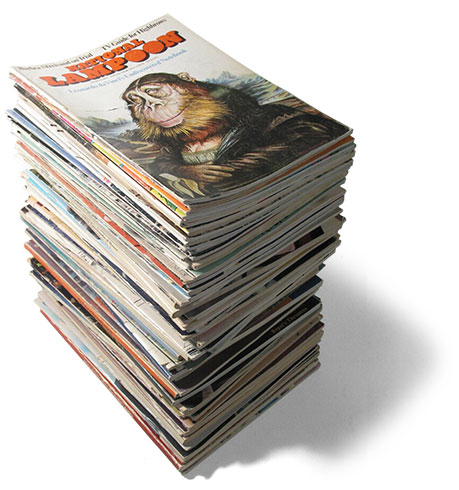

 Two gals from down under have managed to pull off an amazing feat: A pitch-perfect parody of vintage 1970s-era National Lampoon. POX is a comic book published “intermittently” by Susan Butcher and Carol Wood out of somewhere in the middle of Australia. It’s funny, clever, and quirky (and drawn by hand). Carol says she discovered the ‘Poon in the mid-1970s as a 16-year-old living in Perth, Western Australia. It was a mind-blowing experience and Lampoon magazine and books became her only contact with the outside world.
Two gals from down under have managed to pull off an amazing feat: A pitch-perfect parody of vintage 1970s-era National Lampoon. POX is a comic book published “intermittently” by Susan Butcher and Carol Wood out of somewhere in the middle of Australia. It’s funny, clever, and quirky (and drawn by hand). Carol says she discovered the ‘Poon in the mid-1970s as a 16-year-old living in Perth, Western Australia. It was a mind-blowing experience and Lampoon magazine and books became her only contact with the outside world. Which explains the fabulous job she and Susan did on “National Poltroon,” a 16-page parody of National Lampoon featured in POX Number Six. Given their limited resources, it’s not as lavishly produced as the original (black and white on newsprint), but it perfectly captures the tone and style of the magazine at its peak. In a jam-packed 16 pages they manage to have a little fun with practically every artist and writer of the era–P.J. O’Rourke, Chris Miller, Henry Beard, Vaughn Bodé, Michael Gross, Rick Meyerowitz, Bruce McCall(!), and more.
Which explains the fabulous job she and Susan did on “National Poltroon,” a 16-page parody of National Lampoon featured in POX Number Six. Given their limited resources, it’s not as lavishly produced as the original (black and white on newsprint), but it perfectly captures the tone and style of the magazine at its peak. In a jam-packed 16 pages they manage to have a little fun with practically every artist and writer of the era–P.J. O’Rourke, Chris Miller, Henry Beard, Vaughn Bodé, Michael Gross, Rick Meyerowitz, Bruce McCall(!), and more.  There are spoofs of cartoons—Cheech Wizard, Politenessman, Verman, B. Kliban, Edward Gorey, Gahan Wilson, Charles Rodriguez, Roz Chast, Bob Mankoff, Sam Gross, Shary Flenniken, Ed Subitzky, M.K. Brown, Randy Enos, Jeff Jones, Bruce Cochrane, Foto Funnies, etc., etc. Some of these are very brief, but all of them lovingly mimick each cartoonist’s style to a T. Did I mention the subscription cards? The Surprise Poster? The Son ‘o God comics parody? The contents page? The Off-Broadway show? The obligatory “hip” liquor/tobacco/hi-fi ad? It’s hard to believe how much they managed to squeeze into this little parody. It’s clearly a labor of love—as much a tribute as a spoof.
There are spoofs of cartoons—Cheech Wizard, Politenessman, Verman, B. Kliban, Edward Gorey, Gahan Wilson, Charles Rodriguez, Roz Chast, Bob Mankoff, Sam Gross, Shary Flenniken, Ed Subitzky, M.K. Brown, Randy Enos, Jeff Jones, Bruce Cochrane, Foto Funnies, etc., etc. Some of these are very brief, but all of them lovingly mimick each cartoonist’s style to a T. Did I mention the subscription cards? The Surprise Poster? The Son ‘o God comics parody? The contents page? The Off-Broadway show? The obligatory “hip” liquor/tobacco/hi-fi ad? It’s hard to believe how much they managed to squeeze into this little parody. It’s clearly a labor of love—as much a tribute as a spoof. Every so often I hear from someone who was affiliated with National Lampoon in one way or another. The most recent is Andy Moses, an erstwhile comic actor who appeared in the stage production of That’s Not Funny, That’s Sick! Andy is alive and well and living in New York City with his wife and cats. After getting out of the acting business, he became a bartender, a diamond salesman, a chef, and a partner in a comic book store. He still hangs out with some of the old NatLamp players, including the talented Paul Jacobs.
Every so often I hear from someone who was affiliated with National Lampoon in one way or another. The most recent is Andy Moses, an erstwhile comic actor who appeared in the stage production of That’s Not Funny, That’s Sick! Andy is alive and well and living in New York City with his wife and cats. After getting out of the acting business, he became a bartender, a diamond salesman, a chef, and a partner in a comic book store. He still hangs out with some of the old NatLamp players, including the talented Paul Jacobs.
 The Society of Magazine Editors has selected
The Society of Magazine Editors has selected  When I heard the title of Jessica Hendra’s book,
When I heard the title of Jessica Hendra’s book,